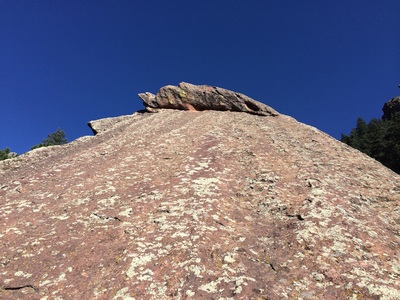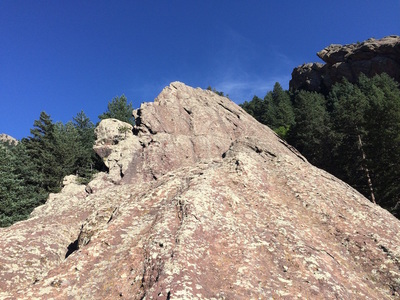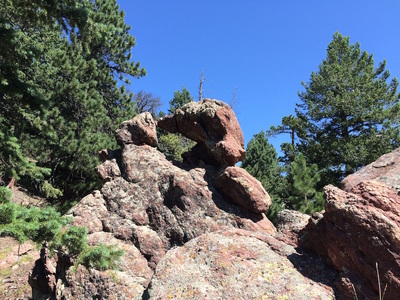Ridge 4 via Mohling Arete (5.4)
East Green Mountain
Green Mountain
7/29/2015
Partners: Michael, Jamie
7.1 miles
2,600' gain
Partners: Michael, Jamie
7.1 miles
2,600' gain
Thoughts: Ridge 4 has been on my to-do Flatiron list, but the vague descriptions of terrifying notch-negotiations kept me off for years. Finally, I coordinated with two of the most versed Flatiron climbers that I know to give it a go. This proved to be one of the most memorable Flatiron routes that I have done. It has bizarre and unique sections of climbing and down-climbing that are uncharacteristic to the Flatirons, and has the most remote feeling of any climb I have done in the area. The overall rock quality is great and the scrambling enjoyable.
Approach:
Starting at NCAR, follow the great trail west to the Mesa Trail and then north to the climber's turnoff to Skunk Canyon. Watching carefully for the copious amounts of poison ivy, follow the "trail" westward while being thankful that the post-flood canyon is much easier to negotiate than before. The climber's trail will eventually end at Ridge 3, and Ridge 4 starts a short distance straight west. The start is a distinctive vertical wall right at the base and is the last rock formation in Skunk Canyon.
Route (S=Section, N=Notch, J=Jump, T=Tree):
**I chose to use sections instead of pitches due to the wide variants in difficulty and large lengths of each section. Plus each is more than a rope length.**
S1 - 5.4 - Starting from the toe of the ridge, scramble to the overhang and then up the slab above it to the easier ridgeline above. Once on the ridge, follow generally easy terrain for several hundred feet to the first notch.
N1 - J - The first notch can be passed by a "safe" jump. No worse than Freeway.
S2 - 3rd class - Easy scrambling leads to broken terrain and an imposing notch.
N2 - 5.5 S or J X - This is the crux of the entire climb and there are 3 choices.
1) Down-climb to the west passing a short tree and traverse back into the notch. The rock is poor quality and the drop would kill you.
2) Climb to the highpoint of the notch and jump across to a sloping boulder. It's about 10 feet across and 15 feet down. Don't miss.
3) Rig a "rappel" from the tree to make a traversing, down-climbing rappel into the notch. This is the safest option.
S3 - 3rd Class - A short stretch of easy terrain leads to...another notch!
N3 - 4th class - Reverse belly-flop into the notch from decent holds near the western side.
S4 - 4th class - Ascend a short, steep wall and move onto an easy ledge on the west side. Walk to the next notch.
N4 - 5.0 - This is the most dramatic notch in regards to exposure. Work into the void and back toward the east via thrilling chimneying onto a chockstone.
S5 - 4th class - Scramble up easy terrain passing another small notch that is easily hopped until reaching a final, deep notch.
N5 - 5.2 or 5.T - This is the end of the "continuous" ridge, and you have to leave the rock no matter what. Scoot down an easy groove to the east to reach a sloping ledge. Move direct north toward the notch and either traverse it back west and then down to the ground, or lean over and climb down the small tree. If you chose the tree, be polite as its branches are small.
S6 - 5.2 - To reach the highest point, hike/scramble around the next few towers on the east to reach the final step of rock of Mohling's Arete. Climb up the southern ridge to the small, yet dramatic summit.
Descent: Walk off the highest point via class 2 rock on the north. Any descent back into Skunk Canyon from here would be less than pleasant but I imagine 4 possibilities each with their own strengths and weaknesses...
1) Hike more or less east passing the highpoints of Ridges 1-3 just to the north. Move just under the northern side of Hillbilly Rock and eventually reach the mesa trail. Pro: Shortest option. Con: Potential for getting lost, moderate bushwhacking.
2) Hike slightly downhill under the southern edge of the Fist and then uphill to a small saddle under the Fist's East Face route. Descend to the east and follow the good climber's trail on the south side of the Fifth Flatiron to Royal Arch. Woods Quarry is a nice cuttoff back to the mesa trail. Pro: Least amount of off-trail hiking. Con: Further distance than option 1.
3) Hike straight uphill to the north following the ridgeline to the summit of East Green Mountain. Countour slightly west to reach the upper Greenma's Trail and follow that to the top of Green Mountain. Descend the Green-Bear trail to Bear Canyon and back to NCAR. Pro: Tags 2 more summits. Con: Adds quite a bit of distance on good trails.
4) Descend down into Skunk Canyon to the west and hike downhill under the west side of Ridge 4 back to the start of the route. Pro: Relatively short compared to options 1-3. Cons: Expect extensive bushwhacking and possible wildlife encounters.
Gear: We did this solo so cannot trulely comment on gear selection. That said, the rock is solid and on the sections harder than 3rd or 4th class there did not appear to be many options for placing protection. The crux notch can be rappelled with a 30M rope, but it is important to note that a 30M rope would likely not reach the ground if you choose to bail off of the ridge at any point.
Starting at NCAR, follow the great trail west to the Mesa Trail and then north to the climber's turnoff to Skunk Canyon. Watching carefully for the copious amounts of poison ivy, follow the "trail" westward while being thankful that the post-flood canyon is much easier to negotiate than before. The climber's trail will eventually end at Ridge 3, and Ridge 4 starts a short distance straight west. The start is a distinctive vertical wall right at the base and is the last rock formation in Skunk Canyon.
Route (S=Section, N=Notch, J=Jump, T=Tree):
**I chose to use sections instead of pitches due to the wide variants in difficulty and large lengths of each section. Plus each is more than a rope length.**
S1 - 5.4 - Starting from the toe of the ridge, scramble to the overhang and then up the slab above it to the easier ridgeline above. Once on the ridge, follow generally easy terrain for several hundred feet to the first notch.
N1 - J - The first notch can be passed by a "safe" jump. No worse than Freeway.
S2 - 3rd class - Easy scrambling leads to broken terrain and an imposing notch.
N2 - 5.5 S or J X - This is the crux of the entire climb and there are 3 choices.
1) Down-climb to the west passing a short tree and traverse back into the notch. The rock is poor quality and the drop would kill you.
2) Climb to the highpoint of the notch and jump across to a sloping boulder. It's about 10 feet across and 15 feet down. Don't miss.
3) Rig a "rappel" from the tree to make a traversing, down-climbing rappel into the notch. This is the safest option.
S3 - 3rd Class - A short stretch of easy terrain leads to...another notch!
N3 - 4th class - Reverse belly-flop into the notch from decent holds near the western side.
S4 - 4th class - Ascend a short, steep wall and move onto an easy ledge on the west side. Walk to the next notch.
N4 - 5.0 - This is the most dramatic notch in regards to exposure. Work into the void and back toward the east via thrilling chimneying onto a chockstone.
S5 - 4th class - Scramble up easy terrain passing another small notch that is easily hopped until reaching a final, deep notch.
N5 - 5.2 or 5.T - This is the end of the "continuous" ridge, and you have to leave the rock no matter what. Scoot down an easy groove to the east to reach a sloping ledge. Move direct north toward the notch and either traverse it back west and then down to the ground, or lean over and climb down the small tree. If you chose the tree, be polite as its branches are small.
S6 - 5.2 - To reach the highest point, hike/scramble around the next few towers on the east to reach the final step of rock of Mohling's Arete. Climb up the southern ridge to the small, yet dramatic summit.
Descent: Walk off the highest point via class 2 rock on the north. Any descent back into Skunk Canyon from here would be less than pleasant but I imagine 4 possibilities each with their own strengths and weaknesses...
1) Hike more or less east passing the highpoints of Ridges 1-3 just to the north. Move just under the northern side of Hillbilly Rock and eventually reach the mesa trail. Pro: Shortest option. Con: Potential for getting lost, moderate bushwhacking.
2) Hike slightly downhill under the southern edge of the Fist and then uphill to a small saddle under the Fist's East Face route. Descend to the east and follow the good climber's trail on the south side of the Fifth Flatiron to Royal Arch. Woods Quarry is a nice cuttoff back to the mesa trail. Pro: Least amount of off-trail hiking. Con: Further distance than option 1.
3) Hike straight uphill to the north following the ridgeline to the summit of East Green Mountain. Countour slightly west to reach the upper Greenma's Trail and follow that to the top of Green Mountain. Descend the Green-Bear trail to Bear Canyon and back to NCAR. Pro: Tags 2 more summits. Con: Adds quite a bit of distance on good trails.
4) Descend down into Skunk Canyon to the west and hike downhill under the west side of Ridge 4 back to the start of the route. Pro: Relatively short compared to options 1-3. Cons: Expect extensive bushwhacking and possible wildlife encounters.
Gear: We did this solo so cannot trulely comment on gear selection. That said, the rock is solid and on the sections harder than 3rd or 4th class there did not appear to be many options for placing protection. The crux notch can be rappelled with a 30M rope, but it is important to note that a 30M rope would likely not reach the ground if you choose to bail off of the ridge at any point.
GPS track of our route...





















